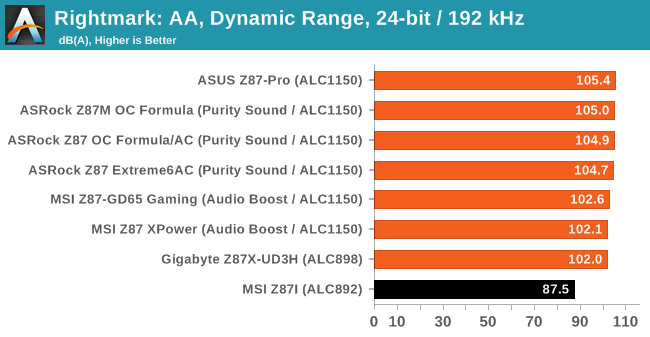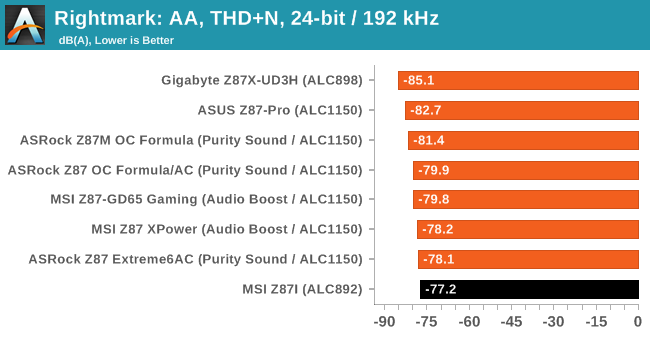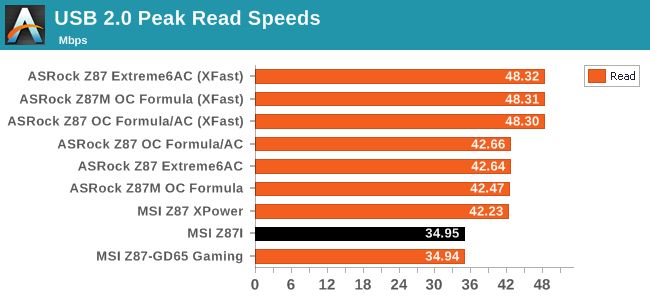MSI Z87I Review: Mini-ITX Haswell for $140
by Ian Cutress on August 27, 2013 10:15 AM EST- Posted in
- Motherboards
- MSI
- Mini ITX
- Z87
System Benchmarks
Rightmark Audio Analyzer 6.2.5
In part due to reader requests, we are pleased to include Rightmark Audio Analyzer results in our benchmark suite. The premise behind Rightmark:AA is to test the input and output of the audio system to determine noise levels, range, harmonic distortion, stereo crosstalk and so forth. Rightmark:AA should indicate how well the sound system is built and isolated from electrical interference (either internally or externally). For this test we connect the Line Out to the Line In using a short six inch 3.5mm to 3.5mm high-quality jack, turn the OS speaker volume to 100%, and run the Rightmark default test suite at 192 kHz, 24-bit. The OS is tuned to 192 kHz/24-bit input and output, and the Line-In volume is adjusted until we have the best RMAA value in the mini-pretest. We look specifically at the Dynamic Range of the audio codec used on board, as well as the Total Harmonic Distortion + Noise.


In terms of dynamic range, the ALC892 leaves a lot to be desired compared to the ALC898 and ALC1150.
USB Backup
For this benchmark, we run CrystalDiskMark to determine the ideal sequential read and write speeds for the USB port using our 240 GB OCZ Vertex3 SSD with a SATA 6 Gbps to USB 3.0 converter. Then we transfer a set size of files from the SSD to the USB drive using DiskBench, which monitors the time taken to transfer. The files transferred are a 1.52 GB set of 2867 files across 320 folders – 95% of these files are small typical website files, and the rest (90% of the size) are the videos used in the WinRAR test. In an update to pre-Z87 testing, we also run MaxCPU to load up one of the threads during the test which improves general performance up to 15% by causing all the internal pathways to run at full speed.


Nothing particularly special about USB speeds, in line with other Z87 MSI motherboards tested in the past.
DPC Latency
Deferred Procedure Call latency is a way in which Windows handles interrupt servicing. In order to wait for a processor to acknowledge the request, the system will queue all interrupt requests by priority. Critical interrupts will be handled as soon as possible, whereas lesser priority requests, such as audio, will be further down the line. So if the audio device requires data, it will have to wait until the request is processed before the buffer is filled. If the device drivers of higher priority components in a system are poorly implemented, this can cause delays in request scheduling and process time, resulting in an empty audio buffer – this leads to characteristic audible pauses, pops and clicks. Having a bigger buffer and correctly implemented system drivers obviously helps in this regard. The DPC latency checker measures how much time is processing DPCs from driver invocation – the lower the value will result in better audio transfer at smaller buffer sizes. Results are measured in microseconds and taken as the peak latency while cycling through a series of short HD videos - under 500 microseconds usually gets the green light, but the lower the better.

Peak DPC latency for Z87 platforms continues to poll over 145 microseconds, suggesting that is still a generational issue. If you want lower, then something other than Z87 might suffice.










46 Comments
View All Comments
Schmov17 - Tuesday, August 27, 2013 - link
Do the dual NICs support teaming?bobbozzo - Tuesday, August 27, 2013 - link
If you want gbps or higher performance, you shouldn't be using Realtek NICs; it's almost impossible to get full gbps speed out of them.Intel, Broadcom, and possibly Qualcomm Atheros are currently the best choices, and the server-model NICs have more virtualization / offloading capabilities than the standard embedded or desktop models.
TheButton - Tuesday, August 27, 2013 - link
I know beggars can't be choosers but I'd love to see a review of the B75(IvyBridge) or B85 (Haswell) mITX motherboards. They are cheap (can be had for <$100) and seem to have all the right features, USB3.0, PCI-E 3.0x16, SATA 6Gbps, 2 Dimm slots. I know they are marketed for small business but they seem ideal for small form-factor gaming machines and I'd love to see how B85 compares versus H81 and/or Z87 especially in the mITX form factor.Can we expect any such reviews to be forthcoming Ian?
DMisner - Tuesday, August 27, 2013 - link
Just curious if under 'Visual Inspection' you could add a picture of the back of the motherboard. I know sometimes motherboard manufacturers place some small parts on the back and often they get in the way of aftermarket cooler back-plates (especially on m-ITX motherboards) which can be a frustrating surprise to find upon delivery.Razorbak86 - Tuesday, August 27, 2013 - link
For this particular motherboard, check Newegg product #4 (out of 5).Razorbak86 - Tuesday, August 27, 2013 - link
... Newegg product photo #4 (out of 5)Ammaross - Tuesday, August 27, 2013 - link
"ALC892 audio solution which performed average in our audio tests. If MSI were aiming more at a HTPC or gaming market, we might have seen an ALC898"Wouldn't most gamers be utilizing a USB-audio headset?
DanNeely - Tuesday, August 27, 2013 - link
One of the reasons I wouldn't want to ever share an apartment is that I can game on speakers; and no one can tell me otherwise.LordHaHa - Tuesday, August 27, 2013 - link
Was there any investigation into undervolting the system? The OC results are positive, but I'd rather use mATX+ for higher performance purposes. On the other hand, I could think of some applications for a low-footprint, low-power, no-to-little-default-performance-sacrifice mITX system.londiste - Wednesday, August 28, 2013 - link
that's what i think when i see any mitx review...additionally, why not give power consumption a go with 35/45w tdp cpu and minimal needed hardware attached. for example 4670t, 1 stick of ram and 1 hdd/ssd, omitting a dedicated gpu entirely? i have several mitx boxes running off picopsu (or similar prebuilt solutions from case manufacturers).